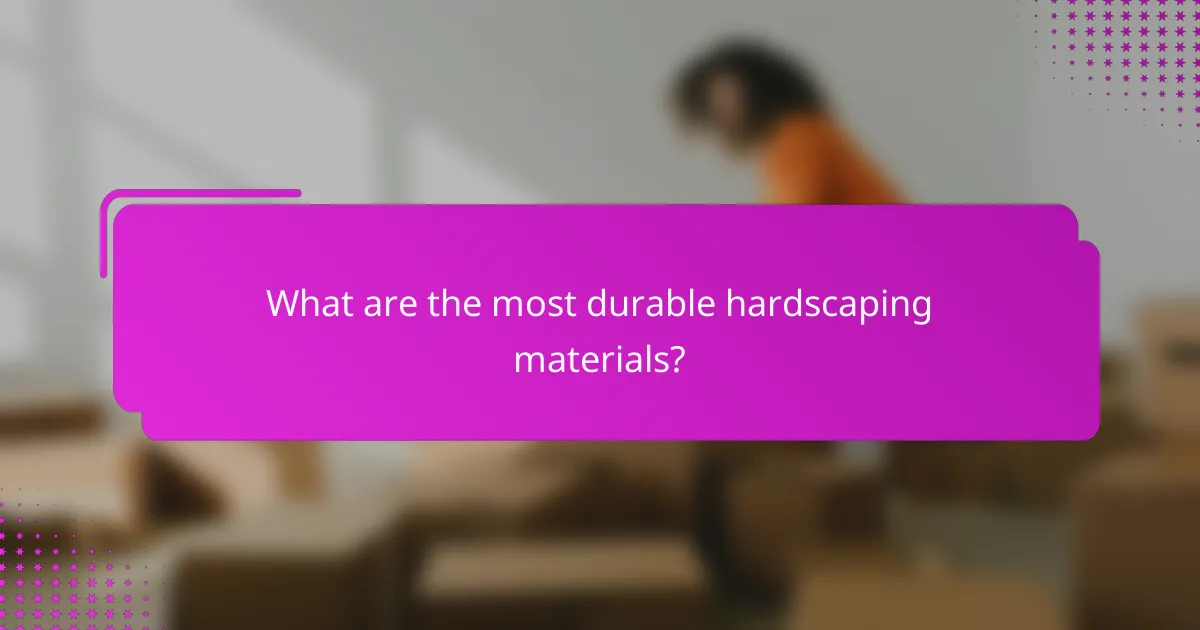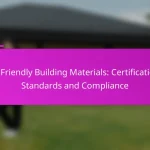Exploring hardscaping options reveals a balance between sustainability, aesthetics, and durability in outdoor design. By selecting materials that minimize environmental impact while enhancing visual appeal, homeowners can create beautiful and functional spaces. Durable choices like granite, brick, and natural stone not only elevate the landscape but also ensure long-lasting performance against the elements.

What hardscaping options are sustainable in urban areas?
Sustainable hardscaping options in urban areas focus on minimizing environmental impact while enhancing aesthetics and durability. These options often incorporate materials that reduce runoff, utilize recycled content, or are sourced responsibly.
Permeable pavers
Permeable pavers are designed to allow water to pass through, reducing stormwater runoff and promoting groundwater recharge. They come in various materials, including concrete and brick, and can be used for driveways, walkways, and patios.
When selecting permeable pavers, consider the local climate and soil conditions, as these factors affect drainage efficiency. Proper installation is crucial to ensure that the pavers function effectively and maintain their durability over time.
Recycled concrete
Recycled concrete is made from crushed concrete debris, which reduces the need for new materials and minimizes landfill waste. This option is often used for aggregate in new concrete or as a base material for hardscaping projects.
Using recycled concrete can be cost-effective, typically ranging from 10-30% less than new concrete. Ensure that the recycled material meets local building codes and standards for structural integrity.
Natural stone
Natural stone, such as granite or slate, is a durable and aesthetically pleasing hardscaping option. It is sourced from quarries and can be used for patios, walls, and pathways, providing a timeless look that blends well with nature.
While natural stone is often more expensive than other materials, its longevity can make it a worthwhile investment. Look for locally sourced stone to reduce transportation emissions and support local economies.
Composite materials
Composite materials, made from a blend of wood fibers and recycled plastics, offer a sustainable alternative to traditional wood decking. These materials are resistant to rot, insects, and fading, making them ideal for outdoor spaces.
When choosing composite materials, consider their environmental certifications, such as those from the Forest Stewardship Council (FSC). They typically come with warranties of 20 years or more, ensuring long-term durability.
Eco-friendly sealants
Eco-friendly sealants protect hardscaping surfaces while minimizing harmful chemicals. These sealants are often water-based and free from volatile organic compounds (VOCs), making them safer for both the environment and human health.
When applying sealants, follow manufacturer instructions for optimal performance and longevity. Regular maintenance, such as reapplication every few years, can help preserve the appearance and functionality of hardscaping materials.

How do hardscaping materials impact aesthetics?
Hardscaping materials significantly influence the overall aesthetics of outdoor spaces by contributing to visual appeal, texture, and color. Choosing the right materials can enhance the beauty of a landscape while also providing functional benefits.
Color and texture variety
The color and texture of hardscaping materials can dramatically alter the look of a space. Options range from natural stone with earthy tones to vibrant pavers that add a pop of color. Mixing different textures, such as smooth concrete with rough stone, can create visual interest and depth.
When selecting colors, consider the surrounding environment and existing landscaping. Neutral tones often complement greenery well, while bold colors can serve as focal points. Aim for a cohesive palette that enhances the overall design.
Design flexibility
Hardscaping offers a high degree of design flexibility, allowing for various layouts and styles. Whether opting for geometric patterns with pavers or organic shapes with natural stone, the choices are extensive. This flexibility enables homeowners to tailor their outdoor spaces to personal preferences and functional needs.
Consider the scale of the project when planning your design. Larger areas may benefit from more substantial materials, while smaller spaces can use intricate patterns to create an illusion of depth. Always keep in mind the balance between hardscaping and softscaping elements.
Integration with landscaping
Effective integration of hardscaping with landscaping enhances the aesthetic appeal of both elements. Hardscaping should complement plants, trees, and other natural features rather than compete with them. For instance, using stone pathways can guide the eye through a garden, creating a harmonious flow.
When planning integration, consider the scale and style of both hardscaping and landscaping. Ensure that materials and colors used in hardscaping align with the surrounding plants. This cohesive approach not only elevates aesthetics but also promotes a more inviting outdoor environment.

What are the most durable hardscaping materials?
The most durable hardscaping materials include granite, brick, concrete, and natural stone. These materials are known for their strength, longevity, and resistance to weathering, making them ideal choices for outdoor spaces.
Granite
Granite is one of the toughest natural stones available, making it an excellent choice for hardscaping. Its resistance to scratching and staining ensures that it maintains its appearance over time, even in high-traffic areas.
When selecting granite for your project, consider its thickness and finish. A polished surface may look stunning but can be slippery when wet, while a honed finish offers better traction. Granite typically ranges from $50 to $150 per square meter, depending on quality and sourcing.
Brick
Brick is a classic hardscaping material known for its durability and aesthetic appeal. It can withstand harsh weather conditions and is resistant to fire and insects, making it a long-lasting option for patios, walkways, and walls.
When using brick, ensure proper installation with a solid base and adequate drainage to prevent shifting and cracking. Brick prices usually range from $30 to $100 per square meter, depending on the type and color.
Concrete
Concrete is a versatile and durable hardscaping material that can be molded into various shapes and finishes. It is highly resistant to wear and can last for decades with minimal maintenance.
Consider using reinforced concrete for added strength, especially in areas with heavy loads. Decorative options like stamped or stained concrete can enhance its visual appeal. The cost of concrete typically ranges from $50 to $120 per square meter, depending on the finish and complexity of the design.
Natural stone
Natural stone, including options like slate, limestone, and sandstone, offers a unique and timeless look for hardscaping. Its durability varies by type, but many natural stones are resistant to weathering and can last for many years.
When choosing natural stone, consider the local climate and how each type performs under specific conditions. Installation can be more labor-intensive, often leading to higher costs, which can range from $70 to $200 per square meter. Proper sealing can enhance longevity and protect against stains.

How to choose the right hardscaping for your property?
Choosing the right hardscaping involves considering factors like climate, maintenance, and local regulations. Each of these elements plays a crucial role in ensuring that your hardscaping is not only aesthetically pleasing but also durable and sustainable.
Assessing climate conditions
Climate conditions significantly influence the choice of hardscaping materials. For instance, areas with high rainfall may require permeable pavers to manage water runoff, while regions with extreme heat might benefit from lighter-colored stones that reflect sunlight.
Consider the temperature fluctuations in your area. Materials like concrete can crack in freezing temperatures, while certain woods may warp in high humidity. Always select materials that can withstand local weather patterns to ensure longevity.
Evaluating maintenance needs
Maintenance requirements vary widely among hardscaping options. Natural stone may require sealing to prevent staining, while concrete is generally low-maintenance but can be prone to cracking.
Assess how much time and effort you are willing to invest in upkeep. For instance, if you prefer a hands-off approach, consider materials that are durable and require minimal care, such as brick or certain composite materials.
Considering local regulations
Local regulations can dictate what materials and designs are permissible for hardscaping. Check with your local zoning office or homeowners association to understand any restrictions or requirements that may apply.
Some areas may have specific guidelines regarding permeable surfaces to manage stormwater runoff or aesthetic standards to maintain neighborhood character. Familiarizing yourself with these regulations can prevent costly changes or fines later on.


